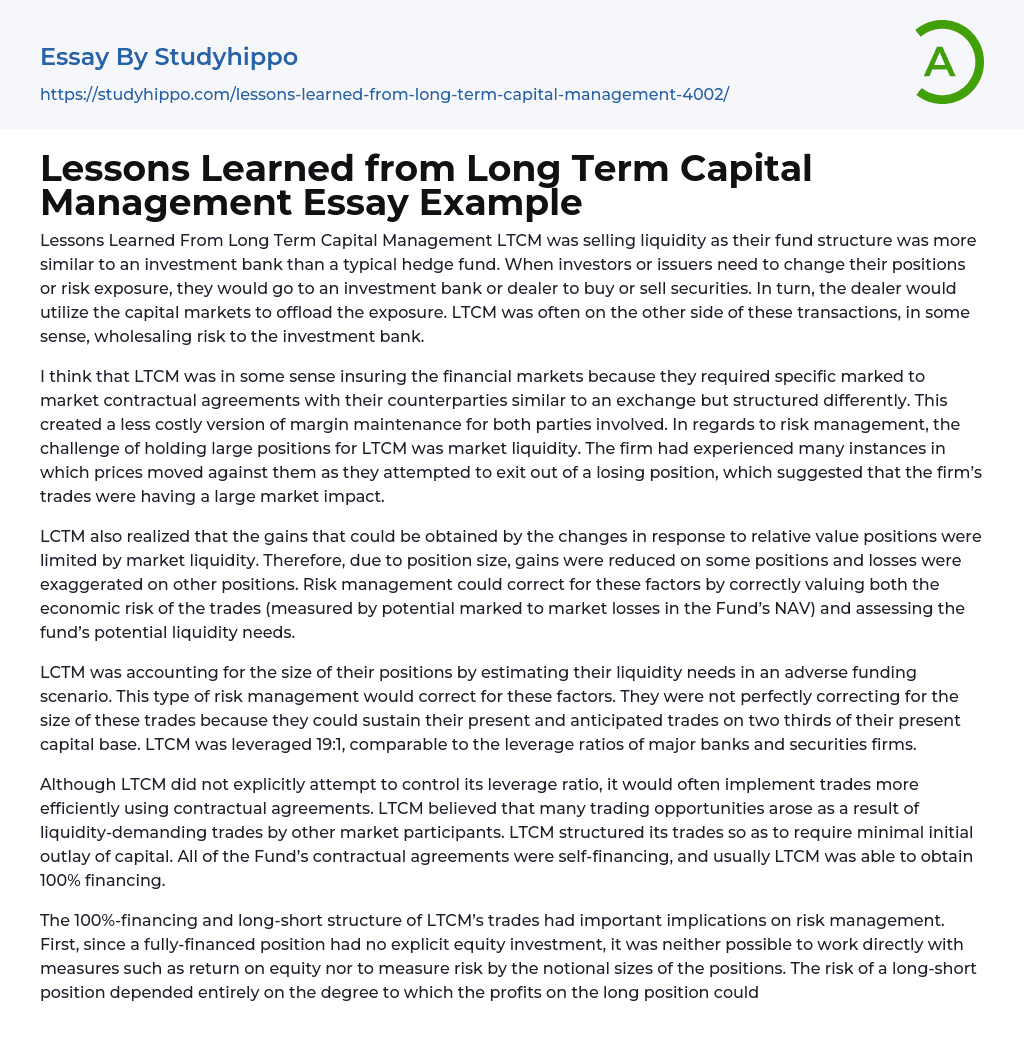

Lessons Learned from Long Term Capital Management Essay Example
Lessons Learned From Long Term Capital Management LTCM was selling liquidity as their fund structure was more similar to an investment bank than a typical hedge fund. When investors or issuers need to change their positions or risk exposure, they would go to an investment bank or dealer to buy or sell securities. In turn, the dealer would utilize the capital markets to offload the exposure. LTCM was often on the other side of these transactions, in some sense, wholesaling risk to the investment bank.
I think that LTCM was in some sense insuring the financial markets because they required specific marked to market contractual agreements with their counterparties similar to an exchange but structured differently. This created a less costly version of margin maintenance for both parties involved. In regards to risk management, the challenge of holding large pos
...itions for LTCM was market liquidity. The firm had experienced many instances in which prices moved against them as they attempted to exit out of a losing position, which suggested that the firm’s trades were having a large market impact.
LCTM also realized that the gains that could be obtained by the changes in response to relative value positions were limited by market liquidity. Therefore, due to position size, gains were reduced on some positions and losses were exaggerated on other positions. Risk management could correct for these factors by correctly valuing both the economic risk of the trades (measured by potential marked to market losses in the Fund’s NAV) and assessing the fund’s potential liquidity needs.
LCTM was accounting for the size of their positions by estimating their liquidity needs in an adverse funding scenario. This type of
risk management would correct for these factors. They were not perfectly correcting for the size of these trades because they could sustain their present and anticipated trades on two thirds of their present capital base. LTCM was leveraged 19:1, comparable to the leverage ratios of major banks and securities firms.
Although LTCM did not explicitly attempt to control its leverage ratio, it would often implement trades more efficiently using contractual agreements. LTCM believed that many trading opportunities arose as a result of liquidity-demanding trades by other market participants. LTCM structured its trades so as to require minimal initial outlay of capital. All of the Fund’s contractual agreements were self-financing, and usually LTCM was able to obtain 100% financing.
The 100%-financing and long-short structure of LTCM’s trades had important implications on risk management. First, since a fully-financed position had no explicit equity investment, it was neither possible to work directly with measures such as return on equity nor to measure risk by the notional sizes of the positions. The risk of a long-short position depended entirely on the degree to which the profits on the long position could deviate from the profits on the short position.
On the other hand, a long-short position could become very risky when the risk of one leg was unrelated to the risk of the other. LTCM measured risk in terms of the probability distribution of potential profits and losses and used “value-at-risk”. LTCM’s believed that as pricing discrepancies became more pronounced, trades based on these discrepancies would attract more capital, and thus the downside risk of a trade diminished. I pledge that I have not violated the Booth Honor Code when completing this
write-up
- Investing essays
- Asset essays
- Depreciation essays
- Discounted Cash Flow essays
- Foreign Direct Investment essays
- Funds essays
- Internal Rate Of Return essays
- Revenue essays
- Day Trading essays
- Futures Trading essays
- Capital market essays
- Million essays
- Payment essays
- Rate Of Return essays
- Funding essays
- Hedge Fund essays
- Leadership and Management essays
- Change Management essays
- Project Management essays
- Knowledge Management essays
- Operations Management essays
- Quality Management essays
- Risk Management essays
- Scientific Management essays
- supply chain management essays
- Performance Management essays
- Time Management essays
- Brand Management essays
- Total Quality Management essays
- Risk essays
- Manager essays
- Leadership essays
- Business Ethics essays
- Board Of Directors essays
- Product Management essays
- Comparative Analysis essays
- Decision Making essays
- Dispute Resolution essays
- Stress Management essays
- Business Management essays
- Brand Equity essays
- Branding essays
- Nike, Inc. essays
- Market share essays
- Razor essays
- Being A Leader essays
- Servant Leadership essays
- Leadership Experience essays
- Leadership Qualities essays
- Incentive essays



